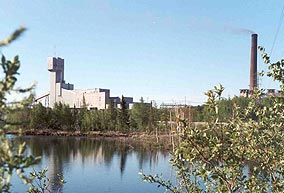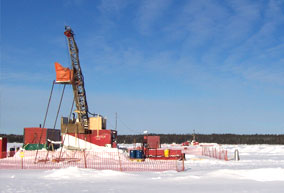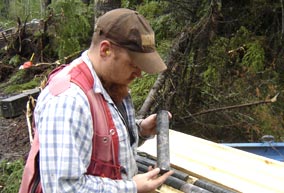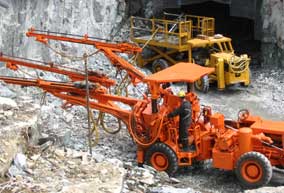Manitoba's Mineral Industry
Exploration and Development Highlights 2005
Base Metals
Precious Metals
Diamonds
Uranium
Specialty/Industrial Minerals
Near record-high prices for base metals, sustained strength in precious metal prices and renewed interest in diamond exploration in Manitoba’s far north are expected to push exploration spending in the province to over $43 million for 2005.
The total area of mining claims and mineral exploration licences as of November 1, 2005 was 5 531 781 hectares compared to 3 298 445 in 2004. The total area of mineral dispositions and leases in good standing as of November 1, 2005 was 5 681 554 hectares compared to 3 492 971 hectares at the end of 2004. Surface exploration diamond drilling in 2005 was 85 000 m, up from 61 766 m in 2004.
In 2002, Manitoba amended The Mines and Minerals Act to change the confidentiality period for assessment reports. As a result, approximately 3000 previously unavailable reports were released to the public domain on November 1, 2005. The new confidentiality period for most reports is a maximum of three years; airborne geophysical surveys have a minimum confidentiality period of five years.
Base Metals
 Inco announced in August that it will spend $45 million to develop the 1-D Lower orebody in Thompson. The orebody is located between the 3600 and 4160 ft. levels at the north end of the Thompson mine. Development will commence in 2006 and first production is scheduled for 2008. The new mine development will also provide access to previously drilled targets that will be reassessed using more advanced technology.
Inco announced in August that it will spend $45 million to develop the 1-D Lower orebody in Thompson. The orebody is located between the 3600 and 4160 ft. levels at the north end of the Thompson mine. Development will commence in 2006 and first production is scheduled for 2008. The new mine development will also provide access to previously drilled targets that will be reassessed using more advanced technology.
Inco also doubled capital spending at its Manitoba operations this year to roughly US$80 million. Planned work includes rebuilding the main smelter furnace. The Thompson smelter will be processing concentrate from Voisey’s Bay beginning in early 2006.
Inco continues to search for new sources of ore in the prolific Thompson Nickel Belt (TNB). In 2005, Inco will have spent approximately $6.5 million for in-mine and surface exploration seeking materials to feed its fully integrated nickel mining and producing operation at Thompson. In addition to these exploration activities, Inco has entered into partnerships with junior explorers including Canadian Royalties Inc. who has conducted geophysics and drilling on their TNB South project. The project covers 70 km of favorable stratigraphy from Halfway Lake south to near Ponton. The five-year agreement that commenced in 2003 requires Canadian Royalties to spend $5 million on exploration.
Also in 2005, Inco and partner Nuinsco Resources Ltd. completed overburden drilling and diamond drilling at the Mel Project that is located 25 km north of Thompson. The multi-year agreement that commenced in 1999 requires Nuinsco Resources to spend $6 million on exploration.
 Crowflight Minerals conducted an extensive winter drill campaign in the Thompson and Wabowden area on their large portfolio of properties under option from Falconbridge. At the Bucko deposit in Wabowden, a National Instrument (NI) 43-101 compliant resource calculation concluded the former nickel producer contains an indicated resource of 1.22 million tonnes of 2.71% nickel. A feasibility study was expected to be completed in the fall. Crowflight commenced a surface in-fill drill program in July hoping to expand Bucko’s indicated resource base by 300 000 tonnes. Results included a 56.0-metre intersection of 2.01% nickel.
Crowflight Minerals conducted an extensive winter drill campaign in the Thompson and Wabowden area on their large portfolio of properties under option from Falconbridge. At the Bucko deposit in Wabowden, a National Instrument (NI) 43-101 compliant resource calculation concluded the former nickel producer contains an indicated resource of 1.22 million tonnes of 2.71% nickel. A feasibility study was expected to be completed in the fall. Crowflight commenced a surface in-fill drill program in July hoping to expand Bucko’s indicated resource base by 300 000 tonnes. Results included a 56.0-metre intersection of 2.01% nickel.
Nuinsco Resources commenced a scoping study to evaluate the potential of open pit and underground mining of the Minago deposit, located 140 km south of Thompson. A recent study concluded Minago contains a measured and indicated resource of 29.84 million tonnes of 0.64% nickel. Winter drilling on the Main zone at Minago returned a 245.9-metre interval of 0.68% nickel with shorter intervals of higher grade mineralization.
Callinan Mines conducted geophysics and drilling at their Phillips Lake and Pine properties near Wabowden. Drilling intersected thick intervals of low-grade nickel-copper sulphides which contained some shorter intervals of higher grade material. Drilling at the Pine property returned a 0.7-metre interval of 2.04% nickel and 0.11% copper.
Seymour Exploration is exploring on mineral leases which cover the past-producing Lynn Lake nickel mine. The mine closed in 1976 after 23 years of production. According to Seymour, historical records indicate that a substantial nickel resource remains in-situ. A resource calculation completed by Wardrop Engineering concluded the property contains a measured and indicated resource of 5.8 million tonnes of 0.85% nickel and 0.39% copper. The study also identified 15 high-priority targets adjacent, and within the mine workings which remain completely untested. Seymour is planning to conduct a drill program to test the new targets.
North American Palladium entered an option agreement to explore five properties held by Rare Earth Metals near Lynn Lake. The properties cover five separate mafic-ultramafic bodies which have similarities to the two intrusives that hosted the Lynn Lake nickel deposits.
Canstar Resources conducted geophysics and drilling in the Seal River area west of Churchill. The company entered an option agreement with holder BHP Billiton Diamonds in 2004 to explore a number of airborne anomalies for base metals and potential kimberlites. Canstar claims that no economic values of base metals or kimberlite were intersected during the 7-hole program.
BHP Billiton Diamonds and partners ValGold Resources, Cream Minerals and Sultan Minerals commenced a 6-hole drill program in mid-March at their Stephens Lake property east of Gillam. The program had to be suspended prematurely due to spring breakup. The companies plan to resume the drill program in early 2006. The Stephens Lake property is extensively covered by glacial till and Paleozoic sedimentary rocks that overlie Precambrian lithologies believed to represent the extension of the Thompson Nickel Belt.
In the Flin Flon–Snow Lake area, Hudbay Minerals (formerly OntZinc Corporation) acquired Hudson Bay Mining and Smelting from Anglo American in late 2004. In February, Hudbay announced that they would spend $10 million on exploration over 12 months on their large Manitoba and Saskatchewan based property portfolio. Hudbay is focusing their exploration strategy on drilling SPECTREM geophysical anomalies, structural fold repeats and targets around existing and former producing mines.
 Mustang Minerals acquired 100% interest in the Mayville property in the Bird River Belt in southeastern Manitoba. Drilling commenced in June to test conductors associated with the 12-km-long layered, mafic-ultramafic Mayville intrusion. By early August, 16 holes had been completed on the M2 zone all intersecting wide intervals (minimum 20-metre true thickness) of sulphide mineralization containing low-grade nickel-copper-PGE values. Within the large mineralized envelope are shorter intervals of higher grade material. Drillhole May-02 for example, contained 33.6 m of 1.06% copper and 0.50% nickel within a 61-metre interval of slightly lower grade sulphides. Other geophysical targets remain to be tested and the M2 zone conductor has 1.2 km of untested strike potential.
Mustang Minerals acquired 100% interest in the Mayville property in the Bird River Belt in southeastern Manitoba. Drilling commenced in June to test conductors associated with the 12-km-long layered, mafic-ultramafic Mayville intrusion. By early August, 16 holes had been completed on the M2 zone all intersecting wide intervals (minimum 20-metre true thickness) of sulphide mineralization containing low-grade nickel-copper-PGE values. Within the large mineralized envelope are shorter intervals of higher grade material. Drillhole May-02 for example, contained 33.6 m of 1.06% copper and 0.50% nickel within a 61-metre interval of slightly lower grade sulphides. Other geophysical targets remain to be tested and the M2 zone conductor has 1.2 km of untested strike potential.
Mustang Minerals also owns 100% interest in the Maskwa nickel deposit 30 km south of the Mayville property. A NI 43-101 compliant resource calculation completed in February estimates Maskwa contains an indicated open pit and underground resource of 6.0 million tonnes of 0.74% nickel and 0.15% copper. Drilling conducted in the spring was successful in extending the Maskwa deposit to the east where it remains open. Mustang is conducting metallurgical work and commencing development of the project.
Lac des Iles Mines (LDI), a wholly owned subsidiary of North American Palladium, entered an option agreement with Gossan Resources to earn a 50% interest in Gossan’s Bird River property in southeastern Manitoba. The property covers 21 km of the Bird River Sill which contains concentrations of PGE, nickel, copper, zinc and chromite. LDI completed an airborne VTEM survey and completed an 8-hole summer drill program. Four of the eight holes encountered sulphide mineralization, the most notable intersection returned 1.08% nickel and 0.50% copper over 13.75 m.
Precious Metals
Bema Gold and Wolfden Resources completed 70 holes during winter and summer/fall drilling at their Monument Bay property in northeast Manitoba. Drilling at the Twin Lakes and Seeber River zones returned some high-grade gold values, including, 4.8 m of 31.71 g/t and 3.28 m of 41.95 g/t. Inferred resources at Monument currently stand at 1.07 million tonnes grading 15.36 g/t gold using 8 grams per tonne cut-off. This resource calculation does not include results from the 2005 winter drill program.
Canadian Gold Hunter conducted a 7-hole drill program on the Hunt zone at depth at their Assean Lake property northeast of Thompson. Three long holes that were drilled to find extensions of the Hunt zone beneath a displacing fault were unsuccessful. The other holes tested the western extension of the Hunt zone and returned mostly low-grade gold values over short intervals. Rare Earth Metals has 40% joint-venture interest in the project.
Rare Earth Metals conducted a short, 2-hole drill program at their Row/Lass and Wood claims which cover the east and west strike directions of Canadian Gold Hunter’s Assean Lake property. Drilling tested separate gold and nickel-copper induced polarization and geochemical anomalies. Neither drillhole returned economic values.
Claude Resources and partner Pioneer Metals completed a 17-hole drill program at their Nokomis Lake gold property near Sherridon. The focus of the drill program was to verify the location and continuity of the host horizon and locate new, near-surface gold zones along strike. Every hole encountered the host horizon, but returned low-grade gold values over 1 to 2 m. The Nokomis gold zone hosts a historic mineral resource estimate of 349 000 tonnes grading 6.10 g/t gold. Claude was also conducting work at the former producing Tartan Lake gold mine near Flin Flon.
Black Pearl Minerals completed a 3000-metre drill program at the Gold Dust and McCafferty zones on the east side of Wekusko Lake near Snow Lake. The drill program consisted of 71 shallow holes along strike from the two zones to define high-grade gold shoots. At Gold Dust, two new high-grade shoots were discovered, returning values up to 17.4 g/t over 4.5 m. At the McCafferty, a new high-grade shoot was discovered, returning 63.74 g/t gold over 1.45 m.
Foran Mining conducted a spring drill program at their North Star property west of Snow Lake. The program was designed to increase the tonnage of the North Star vein system below the 230-metre level. Foran retained Roscoe Postle Associates to prepare an updated mineral resource estimate for the North Star property. The study reported a very limited indicated resource of just over 19 000 tonnes grading 10.6 g/t gold (about 6500 oz. of contained gold) and concluded the resource was insufficient to support a commercial operation.
Falcon Ventures completed a 5-hole drill program at their Butterfly Lake property northeast of Norway House in central Manitoba. The company says all drillholes intersected alteration zones mineralized with pyrite, pyrrhotite and arsenopyrite. The best hole intersected 0.35 m of 6.6 g/t gold.
Alto Ventures acquired a 5516 hectare exploration licence surrounding their Oxford Lake claims. The Oxford Lake property contains the Rusty gold zone which received extensive work by Noranda in the late 1980s. An historical resource estimate based on wide-spaced drilling concluded the Rusty zone contains 800 000 tonnes grading 6 g/t gold. Alto intends to seek a joint-venture partner to further explore the large prospective gold property.
Gossan Resources conducted a summer mapping and geochemical sampling program at their Sharpe Lake property. The project consists of 3 exploration licences covering 40 km of strike length located immediately to the west of the Bema–Wolfden Monument Bay gold property. Geological mapping conducted by the Manitoba Geological Survey in 2003 confirmed that the major deformation zone at Monument Bay, the Stull Lake–Wunnummin Fault Zone, also transects the Sharpe Lake area. Gossan has so far identified two gold occurrences which were to be investigated during the summer work program.
 In southeastern Manitoba, San Gold Resources and Gold City Industries completed their amalgamation process forming the new company San Gold Corporation. San Gold owns the Bissett gold operation (purchased from Harmony Gold Canada) which consists of an 1100-tonne-per-day mill and mine with proven and probable reserves of 818 000 tonnes grading 9.2 g/t gold. San Gold said that the mill would be ready to process the first development ore in December 2005. The company also has 3 other near-surface gold deposits located near the Bissett operation that can supply additional feed to the mill. The San Gold # 1 deposit is the most advanced with a NI 43-101 compliant indicated resource of 256 870 tonnes of 7.5 g/t gold. An access decline is advancing towards the ore body and ore development on the first level (200 ft.) was to begin by December. San Gold #1 will contribute half of the mill feed to the base operating plan of approximately 700 tonnes per day. Recent deep drilling at the San Gold #3 zone returned a high-grade intersection of 6.0 m grading 18 g/t gold. As well, the company says that drilling over 1.1 km of strike on the San Gold #2 and #3 zones indicates a possible continuous gold mineralized horizon open in both directions along strike and to depth.
In southeastern Manitoba, San Gold Resources and Gold City Industries completed their amalgamation process forming the new company San Gold Corporation. San Gold owns the Bissett gold operation (purchased from Harmony Gold Canada) which consists of an 1100-tonne-per-day mill and mine with proven and probable reserves of 818 000 tonnes grading 9.2 g/t gold. San Gold said that the mill would be ready to process the first development ore in December 2005. The company also has 3 other near-surface gold deposits located near the Bissett operation that can supply additional feed to the mill. The San Gold # 1 deposit is the most advanced with a NI 43-101 compliant indicated resource of 256 870 tonnes of 7.5 g/t gold. An access decline is advancing towards the ore body and ore development on the first level (200 ft.) was to begin by December. San Gold #1 will contribute half of the mill feed to the base operating plan of approximately 700 tonnes per day. Recent deep drilling at the San Gold #3 zone returned a high-grade intersection of 6.0 m grading 18 g/t gold. As well, the company says that drilling over 1.1 km of strike on the San Gold #2 and #3 zones indicates a possible continuous gold mineralized horizon open in both directions along strike and to depth.
Wildcat Exploration completed winter drill programs at their Poundmaker and Siderock properties near Bissett. Drilling near the Poundmaker shaft intersected near-surface mineralization grading 41.5 g/t gold over 0.6 m. Drilling at the recently discovered Portage gold zone at the Siderock property intersected multiple intervals of anomalous, up to 3 g/t gold over short to moderate widths. A summer sampling program conducted at the Poundmaker property based on a re-evaluation of historical data identified an auriferous shear zone with at least 2 gold showings. Wildcat says random grab samples from the showings returned gold values up to 16.9 g/t gold.
An initial mapping program conducted at Wildcat’s Garner Lake property returned high-grade gold assays from surface sampling. The program identified 2 gold occurrences within strongly altered and sheared volcanics located near the Beresford Lake Shear Zone. The prospective alteration zones were identified by Manitoba Geological Survey mapping in 2002. Grab samples from an old trench at the first occurrence returned up to 153.2 g/t gold. Assays from samples taken at the second occurrence yielded highly anomalous arsenic (up to 0.9%) and up to 3.8 g/t gold. Wildcat says the area has received very limited diamond drilling and the results merit significant follow-up work.
At Snow Lake, mining and milling operations at the New Britannia mine were suspended in September 2004. In January 2005, joint-venture partners Kinross Gold Corp. (50%) and High River Gold Mines Ltd. (50%) placed the operation on care and maintenance after exploration efforts failed to find the required resource to continue mining. Production at New Britannia began in 1995 and surpassed the mine’s eight-year life expectancy.
Diamonds
The search for diamonds in Manitoba heated up again in late 2004 as interest shifted to the Hudson Bay Lowland and Seal River areas west of Churchill. De Beers Canada secured a 20 000-km² land package at Seal River based on positive sediment samples obtained in earlier surveys. About 40% of the property was covered by an airborne magnetic survey, the balance will be completed in 2006 and drilling of high priority targets will follow.
The De Beers acquisition surrounds claims containing diamond and base-metal targets outlined by BHP Billiton Diamonds who optioned the property to Canstar Resources for further investigations. Western Warrior Resources has conducted several geophysical surveys and ground follow-up work has outlined 35 kimberlite targets at their Eppler Lake property near Seal River. The company is planning a drill program in early 2006 to test the high ranking kimberlite anomalies as well as base and precious metal targets.
In the Hudson Bay Lowland, juniors Falcon Ventures, Diamonds North Resources, Foran Mining and Indicator Explorations acquired exploration licences to search for diamonds.
Diamonds North Resources and Stornoway Diamonds entered a 50:50 joint venture agreement to explore Diamonds North’s Manitoba Highlands project. With Diamonds North as operator, work plans for 2005 included ground geophysics to outline targets for future drilling.
Uranium
The recent surge in uranium prices has renewed exploration interest in the northwest corner of Manitoba. The area received considerable exploration for uranium in the 1960s and 1970s.
CanAlaska Ventures conducted prospecting and a detailed lake-sediment sampling survey on their North East Athabasca project. The project consists of exploration licences that straddle the Manitoba–Saskatchewan border in the far north of both provinces and covers the northern extension of the Wollaston Belt. The focus of the project is shear-hosted deposits and other basement-hosted unconformity-type deposits in an area where many uranium showings were found in the late 1970s. On the Snyder project area, early results from grab sample analyses of mineralized boulders and outcrop returned 0.24% to 1.54% U3O8. CanAlaska is still waiting for results of the extensive lake-sediment sampling program.
Santoy Resources acquired a 100 000 hectare permit adjoining CanAlaska’s permit to the northeast. Santoy intends to identify the source of boulders mineralized with uranium, molybdenum and base and precious metals located by previous explorers.
Specialty/Industrial Minerals
Agrium Inc., a leading global producer of agricultural nutrients, acquired a five-year, 45 000-hectare exploration permit to explore for potash in the St. Lazare area. The company will conduct preliminary seismic work to determine if there are sufficient potash reserves in the area to warrant further potash exploration in the region. If exploration results are successful, Agrium has the option to convert the exploration permit to a potash mineral lease within the five-year term to facilitate mining.
Sunterra Horticulture (Canada) is in its fourth year of sphagnum peat production from a bog located 10 km south of the Lake Winnipeg Narrows, on the west shore. Berger Group continued to develop a sphagnum peat bog 20 km south of Hadashville in southeastern Manitoba. Premiere Horticulture had a fire at its Giroux plant in 2005, but it is anticipated that the plant will be rebuilt.
Gossan Resources acquired two adjacent leases at its Semourville silica sand property, on the east shore of the south basin of Lake Winnipeg, increasing its property size to 274 hectares. A composite of 19 silica sand samples from a drilling program carried out in 2004 returned a silica content of 94.2% without sizing or treatment.
Sodium chlorate for the pulp and paper industry continued to be produced by ERCO Worldwide (a division of Superior Plus Inc.) at their Hargrave plant (10 km east of Virden) and by Nexen at their Brandon plant. Raw material for the ERCO plant is obtained by salt dissolution of the Devonian Prairie Evaporite. Nexen, the world’s largest producer of sodium chlorate, presently purchases salt for its Brandon plant from Saskatchewan potash producers. Nexen completed a $60 million expansion of its Brandon plant to 263 000 tonnes per year, making it the world’s largest sodium chlorate plant.
Lehigh Cement Ltd. acquired several quarry leases near Harcus, on the west shore of Lake Manitoba and began a drilling program to evaluate the gypsum potential. The drilling program is expected to be completed early in 2006.
Tantalum Mining Corporation of Canada Ltd. continued exploration for tantalum- and cesium-bearing pegmatites in the Bernic Lake area in southeastern Manitoba.


